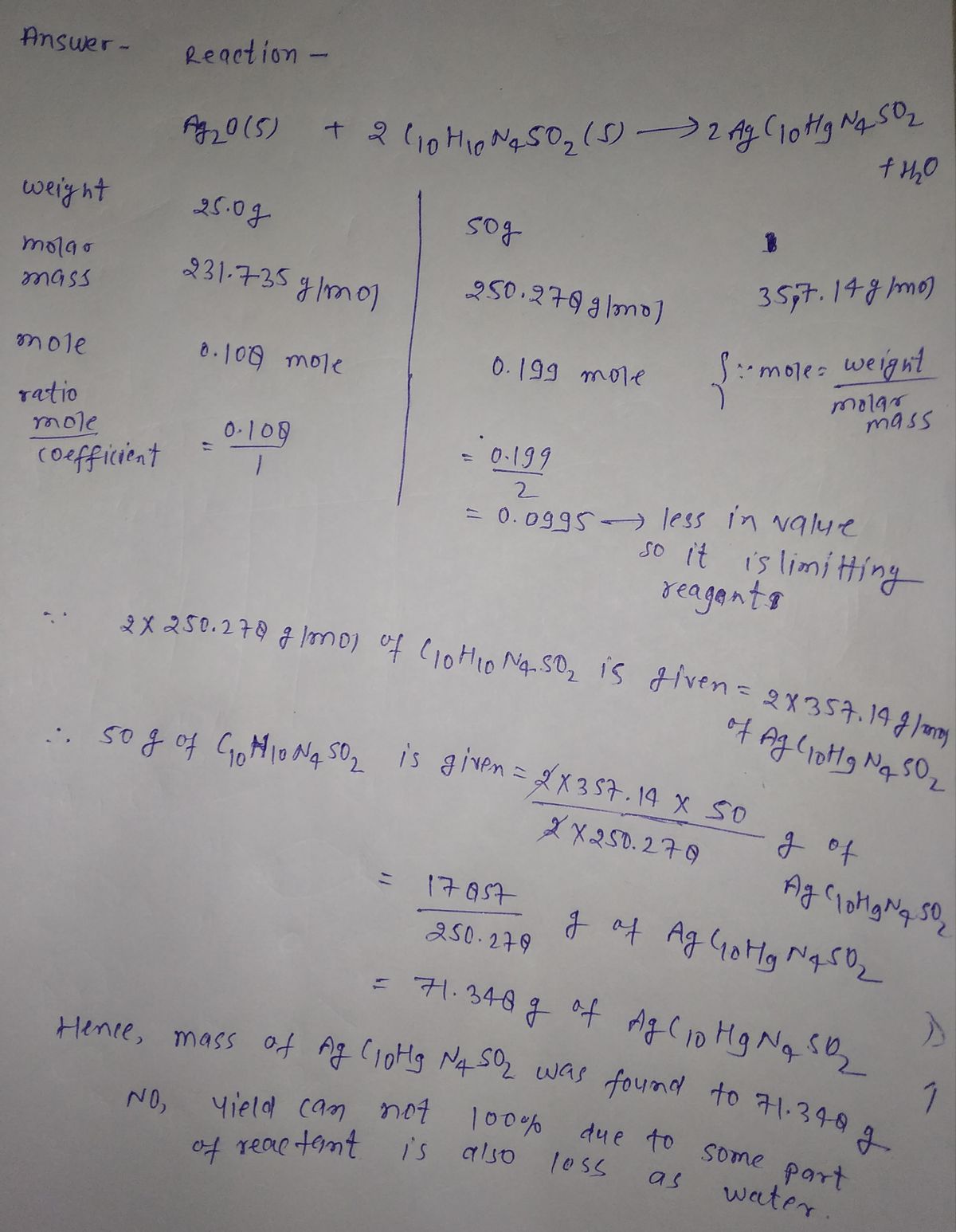Chemistry
10th Edition
ISBN:9781305957404
Author:Steven S. Zumdahl, Susan A. Zumdahl, Donald J. DeCoste
Publisher:Steven S. Zumdahl, Susan A. Zumdahl, Donald J. DeCoste
Chapter1: Chemical Foundations
Section: Chapter Questions
Problem 1RQ: Define and explain the differences between the following terms. a. law and theory b. theory and...
Related questions
Question
100%
![**Title: Calculating Mass of Silver Sulfadiazine in Chemical Reactions**
**Introduction:**
Silver sulfadiazine is widely used in burn treatment as it creates a barrier against bacterial invasion and releases antimicrobial agents. This guide will walk you through the process of calculating the mass of silver sulfadiazine produced in a chemical reaction.
**Problem Statement:**
You are given a reaction between silver oxide (\(Ag_2O\)) and sulfadiazine (\(C_{10}H_{10}N_4SO_2\)):
\[ Ag_2O(s) + 2C_{10}H_{10}N_4SO_2(s) \rightarrow 2AgC_{10}H_9N_4SO_2(s) + H_2O(l) \]
Determine the mass of silver sulfadiazine (\(AgC_{10}H_9N_4SO_2\)) that can be produced from 25.0 g of \(Ag_2O\) and 50.0 g of \(C_{10}H_{10}N_4SO_2\), assuming a 100% yield.
**Steps for Calculation:**
1. **Molar Mass Calculation:**
- Calculate the molar mass of each reactant and product.
- Use these values to convert mass to moles.
2. **Identify the Limiting Reactant:**
- Determine which reactant will produce the lesser amount of product; this is your limiting reactant.
3. **Calculate Theoretical Yield:**
- Use the stoichiometry of the balanced chemical equation to calculate the theoretical yield of the product in moles.
- Convert this moles value to grams using the molar mass of the product.
4. **Mass Entry:**
- Enter the calculated mass in grams (g) in the provided mass input field.
5. **Submission:**
- Once the calculations are complete, submit your answer to check its correctness.
**Additional Features:**
- **Submit Answer Button:** Allows you to submit your calculated mass.
- **Try Another Version Button:** Provides an option to attempt a different version of this problem.
- **Attempt Tracker:** Displays the number of attempts remaining.
This exercise helps reinforce the concepts of stoichiometry, limiting reactants, and yield calculations, essential skills in chemical problem-solving.](/v2/_next/image?url=https%3A%2F%2Fcontent.bartleby.com%2Fqna-images%2Fquestion%2Fe260a345-32eb-45b6-b01c-0d9ccee309e9%2F5d3ef0b2-ab3f-4864-841b-06d4e4199a0f%2F6bv90duj_processed.jpeg&w=3840&q=75)
Transcribed Image Text:**Title: Calculating Mass of Silver Sulfadiazine in Chemical Reactions**
**Introduction:**
Silver sulfadiazine is widely used in burn treatment as it creates a barrier against bacterial invasion and releases antimicrobial agents. This guide will walk you through the process of calculating the mass of silver sulfadiazine produced in a chemical reaction.
**Problem Statement:**
You are given a reaction between silver oxide (\(Ag_2O\)) and sulfadiazine (\(C_{10}H_{10}N_4SO_2\)):
\[ Ag_2O(s) + 2C_{10}H_{10}N_4SO_2(s) \rightarrow 2AgC_{10}H_9N_4SO_2(s) + H_2O(l) \]
Determine the mass of silver sulfadiazine (\(AgC_{10}H_9N_4SO_2\)) that can be produced from 25.0 g of \(Ag_2O\) and 50.0 g of \(C_{10}H_{10}N_4SO_2\), assuming a 100% yield.
**Steps for Calculation:**
1. **Molar Mass Calculation:**
- Calculate the molar mass of each reactant and product.
- Use these values to convert mass to moles.
2. **Identify the Limiting Reactant:**
- Determine which reactant will produce the lesser amount of product; this is your limiting reactant.
3. **Calculate Theoretical Yield:**
- Use the stoichiometry of the balanced chemical equation to calculate the theoretical yield of the product in moles.
- Convert this moles value to grams using the molar mass of the product.
4. **Mass Entry:**
- Enter the calculated mass in grams (g) in the provided mass input field.
5. **Submission:**
- Once the calculations are complete, submit your answer to check its correctness.
**Additional Features:**
- **Submit Answer Button:** Allows you to submit your calculated mass.
- **Try Another Version Button:** Provides an option to attempt a different version of this problem.
- **Attempt Tracker:** Displays the number of attempts remaining.
This exercise helps reinforce the concepts of stoichiometry, limiting reactants, and yield calculations, essential skills in chemical problem-solving.
Expert Solution
Step 1
Mass
Step by step
Solved in 2 steps with 1 images

Knowledge Booster
Learn more about
Need a deep-dive on the concept behind this application? Look no further. Learn more about this topic, chemistry and related others by exploring similar questions and additional content below.Recommended textbooks for you

Chemistry
Chemistry
ISBN:
9781305957404
Author:
Steven S. Zumdahl, Susan A. Zumdahl, Donald J. DeCoste
Publisher:
Cengage Learning

Chemistry
Chemistry
ISBN:
9781259911156
Author:
Raymond Chang Dr., Jason Overby Professor
Publisher:
McGraw-Hill Education

Principles of Instrumental Analysis
Chemistry
ISBN:
9781305577213
Author:
Douglas A. Skoog, F. James Holler, Stanley R. Crouch
Publisher:
Cengage Learning

Chemistry
Chemistry
ISBN:
9781305957404
Author:
Steven S. Zumdahl, Susan A. Zumdahl, Donald J. DeCoste
Publisher:
Cengage Learning

Chemistry
Chemistry
ISBN:
9781259911156
Author:
Raymond Chang Dr., Jason Overby Professor
Publisher:
McGraw-Hill Education

Principles of Instrumental Analysis
Chemistry
ISBN:
9781305577213
Author:
Douglas A. Skoog, F. James Holler, Stanley R. Crouch
Publisher:
Cengage Learning

Organic Chemistry
Chemistry
ISBN:
9780078021558
Author:
Janice Gorzynski Smith Dr.
Publisher:
McGraw-Hill Education

Chemistry: Principles and Reactions
Chemistry
ISBN:
9781305079373
Author:
William L. Masterton, Cecile N. Hurley
Publisher:
Cengage Learning

Elementary Principles of Chemical Processes, Bind…
Chemistry
ISBN:
9781118431221
Author:
Richard M. Felder, Ronald W. Rousseau, Lisa G. Bullard
Publisher:
WILEY